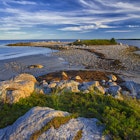
These are Nova Scotia’s 8 best national parks and historic sites
Oct 11, 2021 • 7 min read

Here are the best national parks and historic sites in Nova Scotia © by Marc Guitard / Getty Images
From a star-shaped fort in the middle of the capital city to a remote island inhabited by wild horses, Nova Scotia’s national parks and historic sites include two large national parks, one remote national park reserve, and many museums, nature spots and military reconstructions. They are all operated by Parks Canada.
Kejimkujik National Park
Best national park in Nova Scotia for camping and canoeing
Kejimkujik National Park, one of Nova Scotia’s greatest treasures, is a large forested inland park with dozens of freshwater lakes, rivers and ponds, including the largest and best-known lake, Kejimkujik Lake. It is about 2.5 hours' drive from Halifax.
“Keji,” as it is known to the locals, is famous for its remote back-country sites, accessible only by canoe and portage (carrying a canoe overland), but it also has fantastic options for family camping. Unique Parks Canada accommodations at Keji include yurts, rustic cabins, oTENTiks (canvas-sided cabins), and the Ôasis – a red, raindrop-shaped treehouse.
These lands are an important historic site for Nova Scotia’s Indigenous population, the Mi’kmaq. On the shores of these traditional waterways, there are valuable rock drawings, or petroglyphs, which tell the history of contact between European and Mi’kmaw cultures.
Alexander Graham Bell National Historic Site
Nova Scotia’s tribute to Alexander Graham Bell
Alexander Graham Bell was most famous for the invention of the telephone, but he had plenty of other passions including medicine, flight and a symbolic system called “visible speech” – a written language he developed to teach the deaf to “speak.”
In the late 1800s, Scottish-born Bell set down roots in Baddeck, on Nova Scotia’s Cape Breton Island, where he continued his experiments, most notably setting a marine speed record with his HD-4 hydrofoil, on the beautiful, vast Bras d’Or lake.
After his death, the Bell family donated Bell’s work, and many of his possessions to the Alexander Graham Bell Museum, now one of Parks Canada’s best historic sites. The building itself is designed after a tetrahedron, a shape that formed the basis of many of Bell’s flight experiments.

Fortress of Louisbourg National Historic Site
Nova Scotia’s best immersive historic experience
When the French built Louisbourg in the mid-1700s to protect their colony and fishing grounds in what is now Atlantic Canada, the town was a grand affair. As they built, the French kept detailed records of everything, including every structure, building, plot of land – and every one of the 4000 people who lived there. It wasn’t long before the British attacked Louisbourg – in fact, they attacked it three times, finally demolishing the entire town in the 1760s.
Those original French plans and architectural drawings, stored back in Europe, allowed Nova Scotia to recreate the town 200 years later, as a tourism endeavor. The result: the largest reconstructed site in North America, offering a truly immersive experience in one of the most beautiful parts of Nova Scotia.
Halifax Citadel National Historic Site
Halifax’s most popular national historic site
The fort is called Fort George, but everyone knows it as the Halifax Citadel – a massive star-shaped stone fort built to protect the settlement of Halifax and Halifax Harbour from the mid-1700s until the early twentieth century. These days, the Citadel is a military museum and historic site, with plenty of hands-on experiences like shooting a musket, becoming a soldier for the day, or learning about the Citadel ghosts.
The Halifax Citadel features one of the few remaining noon guns of the British Empire. Every day at precisely noon, a cannon is fired, heard as a great boom across the city.
Citadel hill itself is an enormous geological feature called a drumlin, leftover from the last ice age – a popular place for Haligonians (people from Halifax) to jog, sunbathe, fly kites and toboggan. At the base of Citadel Hill – not managed by Parks Canada, but well worth a visit – is the Halifax Public Gardens, a charming formal Victorian Garden – with a coffee and ice cream shop in the center.

Cape Breton Highlands National Park
Nova Scotia’s best national park for a road trip
Cape Breton Highlands National Park occupies about 367 sq miles (950 sq km) of the northern region of Cape Breton Island, in the northeast Nova Scotia, about 4–5 hours' drive from Halifax. One-third of the world-famous Cabot Trail passes through the park. To drive the trail, you need to buy a park pass, which is well worth the money since Parks Canada does an excellent job of maintaining roadways, hiking trails and lookoff points.
The national park is known for its lush mountain views and 26 well-kept hiking trails. Pitch your tent and stay awhile to explore the beaches, waterfalls, and wildlife (including moose!) in this wild, distant place.
Georges Island National Historic Site
Nova Scotia’s newest Parks Canada experience
Fort Charlotte on Georges Island served as part of Halifax’s defense system from the late 1700s until WWII – a system of military forts, lookouts and weaponry so intimidating that Halifax was never actually attacked. The visitor experience here is one of the newest in the Parks Canada network, following decades of research and reconstruction.
You can take any watercraft to reach Georges Island, which sits in the middle of Halifax Harbour, but the easiest way is to book a tour in advance through local tour company, Ambassatours. Once there, expect some exciting tunnel walks, a grassed-over parade, perfect for a picnic, and stunning photo opportunities looking back toward the city of Halifax.
Fort Anne National Historic Site at Annapolis Royal
Canada’s first national historic site
Fort Anne National Historic Site is located in the middle of the town of Annapolis Royal on the western edge of the Annapolis Valley, about 2 hours' drive from Halifax. After Confederation in 1867, the Dominion of Canada began protecting its parks and historic sites. The first of these was Fort Anne, designated as a “Dominion Park” in 1917.
The history of Annapolis Royal includes stories from Mi’kmaq, Acadian, European, and African Nova Scotian cultures – as well as the history of conflict and reconciliation between them. The museum inside the officer’s quarters, transformed in 2017, is an excellent place to explore this. On the grounds, there are several large grassed ramparts, perfect for catching views, or for rolling down. After your visit, take time to visit the shops, restaurants, and historic gardens in the lovely town of Annapolis Royal.

Sable Island National Park Reserve
The most remote place in Nova Scotia
If wild and distant is within your budget, consider booking yourself a tour to Sable Island, a tiny crescent of sand in the middle of the Atlantic. With no permanent human population, Sable Island’s waters are home to 18 varieties of shark; on its beaches, a colony of wild horses roams, and its shores are a graveyard for over 350 shipwrecks.
The only way to access this remote Parks Canada site is by sea or air, and you must request to visit the island in advance; there’s no way to simply “drop in.” To protect the delicate ecosystem on Sable Island, visitors must undertake biosecurity measures, such as sanitizing shoes, and ensuring that clothing has been freshly washed and has been stored for 5 days before arrival. Sable Island is one of Nova Scotia’s best national parks, and a once-in-a-lifetime experience.
The best way to plan a visit to Sable Island from Nova Scotia is to contact Parks Canada’s partner, Kattuk Expeditions.
Need to know: entry fees and passes
National parks and historic sites in Nova Scotia come with a day entry fee, unless you are a youth aged 17 years or under. New Canadian citizens may also access free entry. The best way to explore Nova Scotia’s best national parks and historic sites is to invest in a Discovery Pass, which provides access to over 80 locations across Canada.
One of the highlights of any Parks Canada experience is meeting friendly Parks Canada staff who are called “interpreters” (not rangers). Chosen for their love of nature, and their unique expertise, you will meet actors, artisans, geologists, historians, Mi’kmaw guides – and even the occasional fiddler amongst Parks Canada staff in Nova Scotia.
You might also like:
Leaf peeping and lobster: when should you visit Nova Scotia?
Lighthouses, whales and fishing villages: 10 best places to visit in Nova Scotia
Nova Scotia is an adventurer's paradise – here are the best things to see and do
Explore related stories


 CampingCurious about Nova Scotia? Consider these 11 fabulous things to do in the province
CampingCurious about Nova Scotia? Consider these 11 fabulous things to do in the provinceMay 24, 2024 • 7 min read







